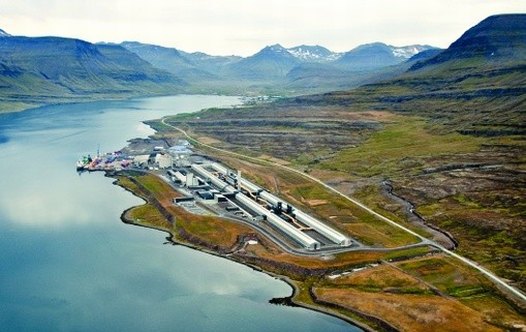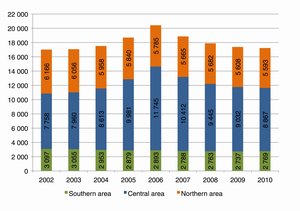
Alcoa Fjarðaál plant in Reyðarfjörður East Iceland. Photo: Emil Þór Sigurðsson
This project was completed in 2008 when the aluminium plant Alcoa Fjarðaál had reached full capacity or 350 000 tonnes annual production and the Kárahnjúkar power station delivered 690 MW or 4600 Gwh. The Alcoa Fjarðaál workforce is roughly 480 in number while a total of around 800 people work on the site. The power plant itself is highly automated and has a staff of only 13 people.
The University of Akureyri Research Centre monitored the social impacts of the project during the period 2004-2010. This research was financed by the government and carried out in accordance with a parliamentary resolution. The research findings were published in 9 separate reports (see: http://www.rha.is/).
In cooperation with local actors the impact area was defined as the eastern part of Iceland divided into three sub-regions. These included a central impact area within two hours average driving distance from the main building sites and two more remote areas; the northern and southern impact areas.
For several decades, plans have existed to use the potential energy supplies held in the glacial rivers in East Iceland to build a large industrial base and create jobs. Very high hopes of prosperity and employment thus existed among the local inhabitants of the area. The region's population and economy had been in relative decline for decades with only a limited diversity of jobs available and a continuing dependence on the primary sector which had been rationalised and thus required a declining amount of manpower. The age and sex distribution showed signs of lengthy out-migration, primarily to the Reykjavík area, with relatively few young adults and women remaining.
During the construction period the region in central East Iceland witnessed huge changes with significant activity and investment in the projects as well as in the housing sector and in other infrastructure construction projects.
The increasing impact of globalisation, as compared to previous large scale projects in Iceland, was also apparent. In the Economic Impact Analysis (EIA) of the Kárahnjúkar project (2001) it was expected that some 20-25% of the workers would come from East Iceland. Instead 9 out of 10 workers were foreign in the summer of 2007 at the peak of the project. Similarly, Icelanders provided 17% of the workers building the aluminium plant but Poles were most numerous at 70%. Environmental demonstrators protested against the projects more vociferously than had previously been the case in Iceland and this also received an elevated level of international attention.
As was to be expected, project participation was highest in the central impact area, where, according to a 2007 survey, approximately 30% of respondents aged 18-65 could be directly connected to the construction project. Next in line was the capital area with 11% reflecting things such as its service capacity and transportation links.
Temporary population growth in the central area was to a large extent caused by the influx of foreign workers. In 2007 the maximum number was reached and around 11 800 persons were registered. The population then declined again. By the end of 2010 the net population increase in the impact area as a whole was merely 200 persons. However there was an increase of 1 100 in the central area while a decline in numbers continued in the more peripheral areas.
 Among the most important findings of the study is how confined the impacts of the projects were within the two municipalities closest to the Alcoa Fjarðaál facility and the Kárahnjúkar power station. Surveys indicated that many positive impacts were felt here. This had to do with rising personal incomes and an increase in the diversity of jobs and services. A survey in 2007 showed that satisfaction with job diversity was highest in the central area of East Iceland, second only to the capital region. Interviews indicated that individuals experienced more optimism and belief in the future of the region. However, data from the municipalities showed that the financial impacts of these new industries only benefited the three central municipalities.
Among the most important findings of the study is how confined the impacts of the projects were within the two municipalities closest to the Alcoa Fjarðaál facility and the Kárahnjúkar power station. Surveys indicated that many positive impacts were felt here. This had to do with rising personal incomes and an increase in the diversity of jobs and services. A survey in 2007 showed that satisfaction with job diversity was highest in the central area of East Iceland, second only to the capital region. Interviews indicated that individuals experienced more optimism and belief in the future of the region. However, data from the municipalities showed that the financial impacts of these new industries only benefited the three central municipalities.
In 2008, after the Fjarðaál facility was opened, it was observed that a significant level of commuting took place to the town of Reyðarfjörður, where the plant is located. It has thus become something of a magnet in this respect. In 2008 54% of the aluminium plant employees originated from East Iceland, and 70% of them were living in the municipality where the plant is located (Fjarðabyggð) The remainder were mostly living in the town of Egilsstaðir some 35 km away.
Production is organised on the basis of a 12 hour shift. It was clear that in such a setting the place of employment has a decisive influence on the social rhythm of life. This was something that was brought out in the interviews conducted with a number of individuals and experts; situations may arise where the 12 hour shift schedules, originally chosen by the Alcoa Fjarðaál staff, may be ill-suited to the needs of the family.
Housing is the policy area where the most obvious mistakes were made, the most striking of which being the excessive level of residential housing construction. Two specialist reports presented the assessment that 70-80 thousand m2 of residential housing needed to be added in the central area in the wake of the aluminium plant's construction.
When the municipalities allocated building permits, however, little regard was apparently paid to those forecasts. In 2008, residential housing had in fact expanded by 135 000 m2, or some 60 000 m2 in excess of research estimates.
Population growth in the central impact area of 11 700 during the period 2002-2008 turned out to be similar to that which had been forecast in the two specialist reports. There appears also to have been significant competition between municipalities with regard to the various building programmes in an attempt to attract new inhabitants.
New infrastructure endowments created in relation to the construction of an aluminium plant and power station in East Iceland have, moreover, been of use to the local communities in various ways and to differing degrees. These include new roads and port installations along with regular import and export flows from that area. This is a mountainous area and many people, both experts and individuals, suggested that to reap the best and most positive benefits from the plants, new road tunnels in the region will have to be constructed. Such projects are however very expensive.
The strength of the 'crowding-out' effect produced by the aluminium plant as yet remains unclear, i.e. how many jobs were cut because of its construction and operation within its labour market. Jobs in fish processing fell sharply in number during the construction period, more than in the previous years. It is interesting however to note that the fishing industry was very supportive of the project, indicating that they felt that they were not in direct competition for labour.
In addition, the significant decline in fish processing jobs leads one to consider how the economy of East Iceland would have developed had there been no heavy industry on the scene. The declining population of the north and south areas of East Iceland most likely provides a good indication of this.
For further information see also the Journal of Nordregio no 2-2007
By Hjalti Jóhannesson, M.A. landfræðingur / geographer, University of Akureyri Research Centre